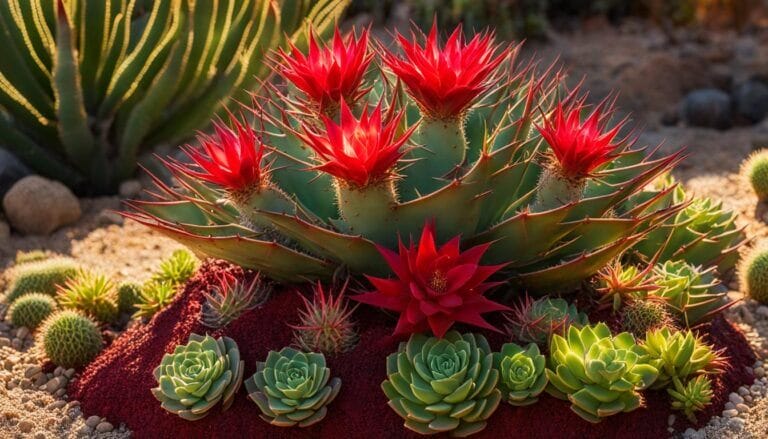Caring for Laceleaf Anthurium Plant: Ideal Light, Water, and Soil Needs
Laceleaf anthuriums, also known as flamingo flowers, are durable and easy-care houseplants. With their heart-shaped leaves and vibrant colors, they make a stunning addition to any indoor space. To ensure that your laceleaf anthurium thrives, it’s important to understand its ideal light, water, and soil needs.
Key Takeaways:
- Laceleaf anthuriums thrive in bright, indirect light.
- Water them when the top few inches of soil become dry.
- Use a well-draining soil mixture to prevent root rot.
- Maintain a warm temperature range between 70-90°F.
- High humidity levels are essential for their growth.
Light Requirements for Laceleaf Anthuriums
Laceleaf anthuriums, also known as flamingo flowers, require bright, indirect light to thrive. Direct sunlight can scorch their delicate leaves and flowers. It’s important to place them in a setting where they receive at least 6 hours of bright, indirect sunlight each day. This can be achieved by positioning them near a north or east-facing window.
If you have limited natural light in your home, you can supplement it with LED grow lights. These lights provide the ideal spectrum for anthuriums and can help maintain their healthy growth and vibrant foliage. It’s important to position the grow lights at the proper distance from the plants to avoid burning their leaves.
“Anthuriums that are admired for their foliage, such as Anthurium superbum and Jungle Bush, can tolerate lower light levels. However, they may not produce as many flowers in low light conditions.”
Regularly inspect your anthuriums for signs of insufficient light. If the leaves start to lose their vibrant color, become pale, or droop, it may indicate that the plant is not receiving adequate light. In such cases, it’s advisable to adjust their positioning to a brighter spot or provide additional artificial lighting.
Table: Light Recommendations for Laceleaf Anthuriums
| Light Level | Description |
|---|---|
| Bright, Indirect Light | Position the plants near a north or east-facing window to receive at least 6 hours of indirect sunlight daily. |
| LED Grow Lights | Supplement natural light with LED grow lights positioned at the proper distance to provide the ideal spectrum for anthuriums. |
| Lower Light Tolerance | Some anthurium varieties, such as Anthurium superbum and Jungle Bush, can tolerate lower light levels, but may produce fewer flowers. |
Watering Tips for Laceleaf Anthuriums
Proper watering is essential for the health and well-being of laceleaf anthuriums. These beautiful plants have specific watering needs that must be met to ensure their growth and vitality. Understanding how often to water anthuriums, establishing a watering schedule, and recognizing their watering needs will help you keep your plants thriving.
How Often to Water Anthuriums
The frequency of watering your laceleaf anthurium will depend on various factors such as the amount of light and warmth it receives. As a general rule, water your anthurium thoroughly when the top few inches of soil become dry to the touch. This ensures that the roots have access to the moisture they need without sitting in saturated soil.
Establishing a Watering Schedule
To establish a watering schedule for your laceleaf anthurium, it’s important to observe the plant’s behavior and monitor the moisture level of the soil. Anthuriums will show signs of thirst when they need to be watered. You may notice the plant becoming lighter when lifted or its leaves appearing droopy or puckered. These signs indicate that it’s time to water your anthurium.
During the winter months, when laceleaf anthuriums are in a period of dormancy, their watering should be reduced. Allow the soil to dry out partially between waterings to prevent the roots from becoming waterlogged. It’s better to underwater than overwater your anthurium, as its roots can be susceptible to rot in excessively wet conditions.
Watering Needs of Anthuriums
Laceleaf anthuriums thrive in high humidity levels, so it’s important to provide them with adequate moisture. While they prefer their soil to dry out partially between waterings, it’s essential to maintain the overall humidity around the plant. You can achieve this by misting the leaves regularly, placing a humidity tray with water and pebbles nearby, or using a humidifier in the room.
It’s important to note that anthuriums are sensitive to chemicals and minerals found in tap water, so it’s best to use filtered or distilled water for watering. This will help prevent the build-up of salts and chemicals in the soil, which can lead to leaf burn and other issues.
| Watering Tips for Laceleaf Anthuriums | Do | Don’t |
|---|---|---|
| Water thoroughly when the top few inches of soil become dry | Use filtered or distilled water to avoid chemical build-up | Overwater and allow the roots to sit in saturated soil |
| Observe signs of thirst in the plant | Mist the leaves regularly to increase humidity | Underwater to prevent root rot |
| Allow the soil to dry partially between waterings | Use a humidity tray or humidifier to maintain overall humidity | Use tap water with high mineral content |
Soil Requirements for Laceleaf Anthuriums
Anthuriums, also known as laceleaf anthuriums or flamingo flowers, require specific soil conditions to thrive. As epiphytes, these plants naturally grow on the surface of other plants or in organic humus. When grown as houseplants, laceleaf anthuriums should be potted in a well-draining soil mixture. The ideal soil for anthuriums is a blend of peat moss or coco coir-based potting soil and drainage materials such as wood chips, perlite, coarse sand, or pumice. This combination allows for quick water drainage and prevents the roots from becoming waterlogged and susceptible to rot.
It is important to choose a potting mix that does not retain excess moisture. Most bagged soil-less potting mixes made for indoor plants work well for laceleaf anthuriums. However, it is crucial to ensure that the soil dries out partially between waterings to prevent soggy soil. If the roots tend to stay wet for too long, adding cactus potting soil mix to the potting soil can further improve drainage.
When repotting laceleaf anthuriums, it is recommended to use a pot that is slightly larger than the previous one and has multiple drainage holes. This allows for better root development and prevents water accumulation at the bottom of the pot. By providing the right soil conditions, you can ensure the health and vitality of your laceleaf anthuriums.
| Soil Requirements for Laceleaf Anthuriums | Ideal Soil Mix |
|---|---|
| Key Characteristics |
|
| Recommended Potting Mix |
|
| Repotting Tips |
|
Temperature and Humidity Preferences for Laceleaf Anthuriums
Laceleaf anthuriums thrive in warm temperatures between 70-90°F. However, they can tolerate typical household temperature ranges as long as they are protected from extreme temperature fluctuations. If the thermostat drops below 50°F, the plant will stop growing, and if it gets too hot, the leaves may wilt. Therefore, it is important to maintain a consistent temperature within the ideal range to ensure the health and growth of your laceleaf anthurium.
Aside from temperature, laceleaf anthuriums also have specific humidity preferences. They thrive in high humidity levels, ideally around 60%. If the humidity level is lower, you can increase the humidity in the immediate vicinity of the plant by using a humidifier or placing small trays with pebbles and water near the plant. These measures will help create a more favorable growing environment for your laceleaf anthurium.
Table: Ideal Temperature and Humidity Range for Laceleaf Anthuriums
| Temperature | Humidity |
|---|---|
| 70-90°F | Around 60% |
By providing your laceleaf anthurium with the ideal temperature and humidity conditions, you will promote healthy growth and ensure that your plant thrives in its environment. Remember to monitor the temperature and humidity levels regularly and make adjustments as needed to maintain the optimal conditions for your laceleaf anthurium’s well-being.
Next, I will share some valuable tips on how to encourage blooming and propagate laceleaf anthuriums for continued enjoyment of their beautiful flowers.
Tips for Blooming and Propagating Laceleaf Anthuriums
If you want your laceleaf anthurium to bloom beautifully, there are a few tips you can follow. First, make sure to provide the plant with the right nutrients. During the growing season, use a fertilizer that is higher in phosphorus, as this will help promote flowering. Additionally, regularly remove any faded flowers by snipping them off at the base. This will encourage the plant to produce new blooms.
Propagating laceleaf anthuriums can be a rewarding way to expand your collection. One popular method is through air root or stem cuttings. Simply take a healthy stem cutting and plant it in fresh potting mix, making sure to keep the soil moist. Within a few weeks, you should start to see new growth. Repotting the plant into a slightly larger pot every couple of years can also help stimulate its blooming cycle.
FAQ
What is the ideal light requirement for laceleaf anthuriums?
Laceleaf anthuriums thrive in bright, indirect light. They should be placed in a setting where they receive at least 6 hours of bright, indirect sunlight each day. If you have limited light in your home, you can supplement natural light with LED grow lights.
How often should laceleaf anthuriums be watered?
Laceleaf anthuriums should be watered thoroughly when the top few inches of soil become dry to the touch. Avoid over-watering, as their roots are susceptible to rot. The frequency of watering will depend on the amount of light and warmth the plant receives.
What type of soil do laceleaf anthuriums need?
Laceleaf anthuriums prefer well-draining soil that allows water to drain quickly. A potting soil mix with added drainage materials, such as wood chips, perlite, coarse sand, or pumice, is recommended. Most bagged soil-less potting soil made for indoor plants will work fine, but ensure that the soil dries out completely before watering again.
What are the temperature and humidity preferences for laceleaf anthuriums?
Laceleaf anthuriums prefer very warm temperatures between 70-90°F. They can tolerate typical household temperature ranges but should be protected from temperature extremes. Anthuriums thrive in high humidity levels, ideally around 60%. If the humidity level is lower, using a humidifier or placing small trays with pebbles and water near the plant can help increase humidity in the immediate vicinity.
How can I encourage blooming and propagate laceleaf anthuriums?
To encourage flowering, use a fertilizer higher in phosphorus during the growing season. Remove faded flowers by snipping them off at the base. Propagation can be done through air root or stem cuttings. Plant the cuttings in fresh potting mix and keep the soil moist. Repotting into a larger pot every two years can help keep the plant’s blooming cycle going.







